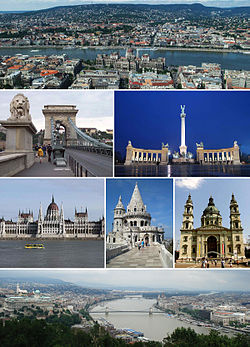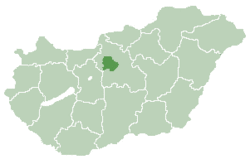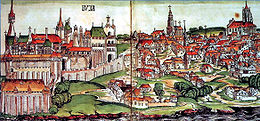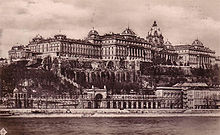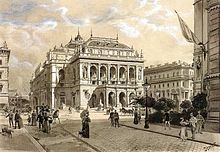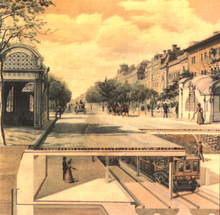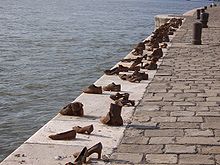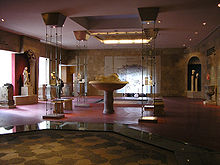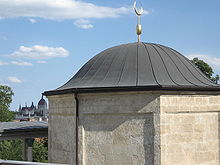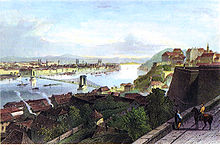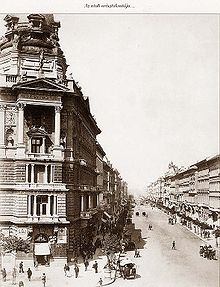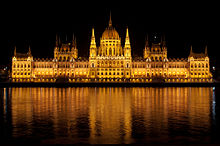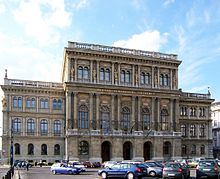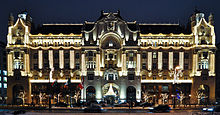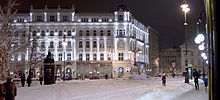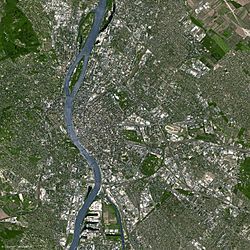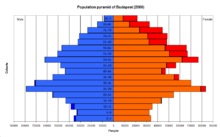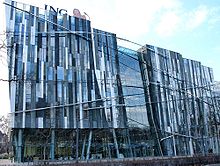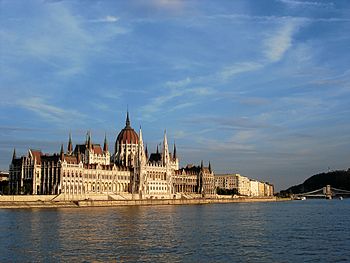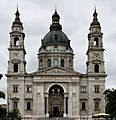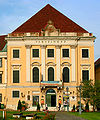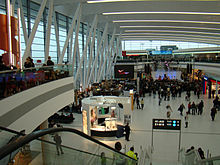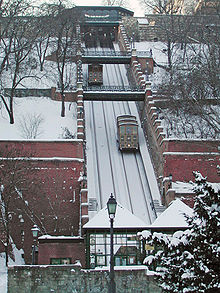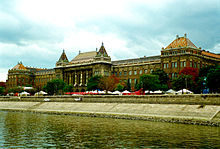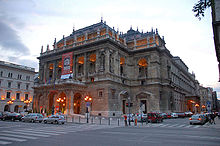- Budapest
-
For other uses, see Budapest (disambiguation).
Budapest — City — From top, left to right: view of the city with the Danube River, lion guarding the Chain Bridge, Heroes' Square, the Parliament Building, Fisherman's Bastion, St. Stephen's Basilica, and a panorama from Gellért Hill with Buda Castle on the left. 
Flag
Coat of armsNickname(s): Heart of Europe, Pearl of Danube, Capital city of Freedom, Capital City of Spas and Thermal Baths, Capital City of Festivals, Capital of the Amazon painters Location of Budapest in Hungary Coordinates: 47°28′19″N 19°03′01″E / 47.47194°N 19.05028°ECoordinates: 47°28′19″N 19°03′01″E / 47.47194°N 19.05028°E Country Hungary Region Central Hungary Subregion Budapesti Unification of Buda, Pest and Óbuda 17 November 1873 Boroughs - Várkerület
- II. kerület
- Óbuda-Békásmegyer
- Újpest
- Belváros-Lipótváros
- Terézváros
- Erzsébetváros
- Józsefváros
- Ferencváros
- Kőbánya
- Újbuda
- Hegyvidék
- XIII. kerület
- Zugló
- XV. kerület
- XVI. kerület
- Rákosmente
- Pestszentlőrinc-Pestszentimre
- Kispest
- Pesterzsébet
- Csepel
- Budafok-Tétény
- Soroksár
Government - Mayor István Tarlós (Fidesz-KDNP) Area - City 525.16 km2 (202.8 sq mi) - Urban 2,538 km2 (979.9 sq mi) - Metro 7,626 km2 (2,944.4 sq mi) Highest elevation 527 m (1,729 ft) Lowest elevation 96 m (315 ft) Population (2011) - City 1,733,685 - Density 3,301.3/km2 (8,550.2/sq mi) - Urban 2,551,247 - Urban density 1,005.2/km2 (2,603.5/sq mi) - Metro 3,284,110 - Metro density 430.6/km2 (1,115.4/sq mi) Demonym budapesti Time zone CET (UTC+1) - Summer (DST) CEST (UTC+2) Postal code(s) 1011–1239 Area code 1 ISO 3166 code HU-BU Website budapest.hu
touristinfo: [2]Budapest (
 /ˈbuːdəpɛst/, /ˈbuːdəpɛʃt/ or /ˈbʊdəpɛst/; Hungarian pronunciation: [ˈbudɒpɛʃt] (
/ˈbuːdəpɛst/, /ˈbuːdəpɛʃt/ or /ˈbʊdəpɛst/; Hungarian pronunciation: [ˈbudɒpɛʃt] ( listen); names in other languages) is the capital of Hungary.[1] As the largest city of Hungary, it is the country's principal political, cultural, commercial, industrial, and transportation centre.[2] In 2011, Budapest had 1,733,685 inhabitants,[3] down from its 1989 peak of 2,113,645[4] due to suburbanization.[5] The Budapest Commuter Area is home to 3,284,110 people.[6][7] The city covers an area of 525 square kilometres (202.7 sq mi)[8] within the city limits. Budapest became a single city occupying both banks of the river Danube with a unification on 17 November 1873 of west-bank Buda and Óbuda with east-bank Pest.[8][9]
listen); names in other languages) is the capital of Hungary.[1] As the largest city of Hungary, it is the country's principal political, cultural, commercial, industrial, and transportation centre.[2] In 2011, Budapest had 1,733,685 inhabitants,[3] down from its 1989 peak of 2,113,645[4] due to suburbanization.[5] The Budapest Commuter Area is home to 3,284,110 people.[6][7] The city covers an area of 525 square kilometres (202.7 sq mi)[8] within the city limits. Budapest became a single city occupying both banks of the river Danube with a unification on 17 November 1873 of west-bank Buda and Óbuda with east-bank Pest.[8][9]The history of Budapest began with Aquincum, originally a Celtic settlement[10][11] that became the Roman capital of Lower Pannonia.[10] Hungarians arrived in the territory[12] in the 9th century. Their first settlement was pillaged by the Mongols in 1241-42.[13] The re-established town became one of the centres of Renaissance humanist culture[14] in the 15th century.[15] Following the Battle of Mohács and nearly 150 years of Ottoman rule,[16] development of the region entered a new age of prosperity in the 18th and 19th centuries, and Budapest became a global city after the 1873 unification.[17] It also became the second capital of Austria-Hungary, a great power that dissolved in 1918. Budapest was the focal point of the Hungarian Revolution of 1848, the Hungarian Soviet Republic of 1919, Operation Panzerfaust in 1944, the Battle of Budapest of 1945, and the Revolution of 1956.
Cited as one of the most beautiful cities in Europe,[1][18][19] its extensive World Heritage Site includes the banks of the Danube, the Buda Castle Quarter, Andrássy Avenue, Heroes' Square and the Millennium Underground Railway, the second oldest in the world.[18][20] Other highlights include a total of 80 geothermal springs,[21] the world's largest thermal water cave system,[22] second largest synagogue, and third largest Parliament building. The city attracts about 2.7 million tourists a year, making it the 37th most popular city in the world according to Euromonitor.[23]
Considered a financial hub in Central Europe,[24] the city ranked 3rd (out of 65 cities) on Mastercard's Emerging Markets Index,[25] and ranked as the most livable Central/Eastern European city on EIU's quality of life index.[26][27] It is also ranked as "Europe's 7th most idyllic place to live" by Forbes,[28] and as the 9th most beautiful city in the world by UCityGuides.[29] It is the highest ranked Central/Eastern European city on Innovation Cities' Top 100 index.[30][31]
Budapest is home to the headquarters of the European Institute of Innovation and Technology (EIT),[32] and the first foreign office of the CIPA.[33]
Contents
The view
Panorama at night photographed from Gellért Hill, showing from left to right the Matthias Church, Buda Castle, Széchenyi Chain Bridge, Danube Promenade and the Parliament
History
Main article: History of BudapestThe first settlement on the territory of Budapest was built by Celts[10] before 1 AD. It was later occupied by the Romans. The Roman settlement - Aquincum - became the main city of Lower Pannonia[10] in 106 AD.[10] The Romans constructed roads, amphitheaters, baths and houses with heated floors in this fortified military camp.[34]
The peace treaty of 829 added Pannonia to Bulgaria due to the victory of Bulgarian army of Omurtag over Holy Roman Empire of Louis the Pious. Budapest arose out of two Bulgarian military frontier fortresses Buda and Pest, situated on the two banks of Danube.[35] Hungarians led by Árpád settled in the territory at the end of the 9th century,[12][36] and a century later officially founded the Kingdom of Hungary.[12] Research places the probable residence of the Árpáds as an early place of central power near what became Budapest.[37] The Tatar invasion in the 13th century quickly proved that defence is difficult on a plain.[8][12] King Béla IV of Hungary therefore ordered the construction of reinforced stone walls around the towns[12] and set his own royal palace[13] on the top of the protecting hills of Buda. In 1361[13] it became the capital of Hungary.[8]
The cultural role of Buda was particularly significant during the reign of Matthias Corvinus of Hungary.[8] The Italian Renaissance had a great influence on the city.[8] His library, the Bibliotheca Corviniana,[8] was Europe's greatest collection of historical chronicles and philosophic and scientific works in the 15th century, and second only in size to the Vatican Library.[8] After the foundation of the first Hungarian university in Pécs in 1367,[38] the second one was established in Óbuda in 1395.[38] The first Hungarian book was printed in Buda in 1473.[39] Buda had about 5,000 inhabitants around 1500.[40]
 During the Hungarian Soviet Republic in 1919, the Heroes Square of Budapest was completely covered by red textile and at the base of the obelisk a new statue was erected: Marx with a worker and a peasant. The statues of Hungarian national heroes were toppled.[41] The Hungarian national symbols were banned, many Hungarian historic monuments were destroyed in the name of internationalism.
During the Hungarian Soviet Republic in 1919, the Heroes Square of Budapest was completely covered by red textile and at the base of the obelisk a new statue was erected: Marx with a worker and a peasant. The statues of Hungarian national heroes were toppled.[41] The Hungarian national symbols were banned, many Hungarian historic monuments were destroyed in the name of internationalism.
The Ottomans pillaged Buda in 1526, besieged it in 1529, and finally occupied it in 1541. The Turkish occupation lasted for more than 140 years.[8] The Turks constructed many fine bathing facilities within the city.[12] Under Ottoman rule many Christians became Muslim. By 1547 the number of Christians was around one thousand. In 1647 it had fallen to about seventy.[40] The unoccupied western part of the country became part of the Habsburg Empire as Royal Hungary.
In 1686, two years after the unsuccessful siege of Buda, a renewed campaign was started to enter the Hungarian capital. This time, the Holy League's army was twice as large, containing over 74,000 men, including German, Croat, Dutch, Hungarian, English, Spanish, Czech, Italian, French, Burgundian, Danish and Swedish soldiers, along with other Europeans as volunteers, artilleryman, and officers, the Christian forces reconquered Buda, and in the next few years, all of the former Hungarian lands, except areas near Timişoara (Temesvár), were taken from the Turks. In the 1699 Treaty of Karlowitz these territorial changes were officially recognized, and in 1718 the entire Kingdom of Hungary was removed from Ottoman rule.
The city was destroyed during the battle.[8] Hungary was then incorporated into the Habsburg Empire.[8]
The 19th century was dominated by the Hungarian struggle for independence[8] and modernization. The national insurrection against the Habsburgs began in the Hungarian capital in 1848 and was defeated a little more than a year later.
1867 was the year of Reconciliation that brought about the birth of Austria-Hungary.
This made Budapest the twin capital of a dual monarchy. It was this compromise which opened the second great phase of development in the history of Budapest, lasting until World War I. In 1873 Buda and Pest were officially merged with the third part, Óbuda (Ancient Buda), thus creating the new metropolis of Budapest. The dynamic Pest grew into the country's administrative, political, economic, trade and cultural hub. Budapest went from about 80% German-speaking in 1848 to about 80% Hungarian-speaking in 1880.[42] The capital, Budapest, was 23% Jewish. Due to the prosperity and the large Jewish community of the city, Budapest was often called the "Jewish Mecca"[43] World War I brought the Golden Age to an end. In 1918 Austria-Hungary lost the war and collapsed; Hungary declared itself an independent republic. In 1920 the Treaty of Trianon finalized the country's partition, as a result, Hungary lost over two-thirds of its territory, about two-thirds of its inhabitants under the treaty including 3.3 million out of 10 million ethnic Hungarians.[44][45]
In 1944, towards the end of World War II, Budapest was partly destroyed by British and American air raids. From 24 December 1944 to 13 February 1945, the city was besieged during the Battle of Budapest. Budapest suffered major damage caused by the attacking Soviet troops and the defending German and Hungarian troops. All bridges were destroyed by the Germans. More than 38,000 civilians lost their lives during the conflict.
Between 20% and 40% of Greater Budapest's 250,000 Jewish inhabitants died through Nazi and Arrow Cross Party genocide during 1944 and early 1945.[46] Despite this, modern day Budapest has the highest number of Jewish citizens per capita of any European city. The Swedish diplomat Raoul Wallenberg managed to save the lives of tens of thousands of Jews in Budapest by giving them Swedish passports and taking them under his consular protection.[47]
In 1949, Hungary was declared a communist People's Republic. The new Communist government considered the buildings like the Buda Castle symbols of the former regime, and during the 1950s the palace was gutted and all the interiors were destroyed.
In 1956, peaceful demonstrations in Budapest led to the outbreak of the Hungarian Revolution. The Leadership collapsed after mass demonstrations began on 23 October, but Soviet tanks entered Budapest to crush the revolt. Fighting continued until early November, leaving more than 3000 dead.
From the 1960s to the late 1980s Hungary was often satirically referred to as "the happiest barrack" within the Eastern bloc, and much of the wartime damage to the city was finally repaired. Work on Erzsébet Bridge, the last to be rebuilt, was finished in 1965. In the early 1970s, Budapest Metro's East-West M2 line was first opened, followed by the M3 line in 1982. In 1987, Buda Castle and the banks of the Danube were included in the UNESCO list of World Heritage Sites. Andrassy Avenue (including the Millennium Underground Railway, Hősök tere and Városliget) was added to the UNESCO list in 2002. In the 1980s the city's population reached 2.1 million. In recent times a significant decrease in population occurred mainly due to a massive movement to the neighbouring agglomeration in Pest county. In the last decades of the 20th century the political changes of 1989-90 concealed changes in civil society and along the streets of Budapest. The monuments of the dictatorship were taken down from public places, into Memento Park. In the first 20 years of the new democracy the development of the city was managed by Gábor Demszky.
Timeline of the history of Budapest
Year Event BC Neolithic, Chalcolithic-, bronze and iron age cultures, Celtic and Eravisci settlements on present day Budapest. 1st century Romans found the settlements known as Aquincum, Contra-Aquincum and Campona. Aquincum becomes the largest town of the Danubian region and one of the capitals of Pannonia. 5th century The Age of Huns. King Attila builds a city for himself here according to later chronicles. After his death, the sons of his brother Mundzuk (Hungarian: Bendegúz, Turkish: Boncuk), Attila and Bleda (Hungarian:Buda), in control of the united Hun tribes. 896 Following the foundation of Hungary, Árpád, leader of the Hungarians, settles in the "Town of Attila", usually identified as Aquincum. 1046 Bishop Gellért dies at the hands of pagans on present-day Gellért Hill. 1241 Tatar invasions destroy both towns. King Béla IV builds the first royal castle on Castle Hill, Buda in 1248. The new town adopts the name of Buda from the earlier one (present day Óbuda). Pest is surrounded by city walls. 1270 Saint Margaret of Hungary dies in a cloister on the Isle of Rabbits (present day Margaret Island). 1458 The noblemen of Hungary elect Matthias Corvinus (in Latin) or Hunyadi Mátyás (in Hungarian) as king on the ice of the Danube. Under his reign Buda becomes a main hub of European Renaissance. He dies in 1490, after capturing Vienna in 1485. 1541 The beginning of Ottoman occupation. The Turkish Pashas build multiple mosques and baths in Buda. 1686 Buda and Pest are reconquered from the Turks with Habsburg leadership. Both towns are destroyed completely in the battles. 1690s Resettlement, initially only a few hundred German settlers. 1773 Election of the first Mayor of Pest. 1777 Maria Theresa of Austria moves Nagyszombat University to Castle Hill. 1783 Joseph II places the acting government (Helytartótanács) and Magyar Kamara on Buda. 1795 20 May Ignác Martinovics and other Jacobin leaders are executed on Vérmező or 'The Field of Blood'. 1810 A fire in the Tabán district. 1825 Commencement of the Reform Era. Pest becomes the cultural and economic centre of the country. The first National Theatre is built, along with the Hungarian National Museum. 1838 The biggest flood in recent memory in March completely inundates Pest. 1848 15 March Start of the Revolution and War of Independence of 1848-49. Pest replaces Pozsony/Pressburg (Bratislava) as the new capital of Hungary and seat of the Batthyány government and the Parliament. 1849 The Austrians occupy the city in early January, but the Hungarian Honvédsereg (Army of National Defense) reclaims it in April, taking the fortress of Buda on May 21 after an 18-day siege. In July, the Habsburg army again captures the two towns. 1849 6 October Lajos Batthyány, the first Hungarian Prime Minister is executed on the present-day Szabadság tér. 1849 Széchenyi Lánchíd, or Széchenyi Chain Bridge, the first permanent bridge across the Danube in Budapest was opened linking Buda (West bank) and Pest (East bank). 1867 Austro-Hungarian Compromise of 1867, followed by unprecedented civic development, resulting in the style of present day Budapest. 1873 The former cities: Pest, Buda and Óbuda are united, and with that the Hungarian capital is established with the name of Budapest. 1874 The Budapest Cog-wheel Railway service is inaugurated. 1878 Electric public lighting installed in the city centre. 1893 Electrification of Budapest finished 1896 Millennium celebrations, the Millennium Underground is inaugurated, and the Ferenc József híd (today's Freedom Bridge) is opened. 1909–1910 Electric public lighting expanded to the suburbs, the nearby towns villages had Electric public lighting. 1910 The census finds 880,000 people in Budapest and 55,000 in the largest suburb of Újpest (now part of Budapest). The religious make-up was 60.9% Catholic, 23.1% Jewish, 9.9% Calvinist and 5.0% Lutheran. Újpest was 65.9% Catholic, 18.4% Jewish, 9.7% Calvinist and 4.5% Lutheran. The percentage of ethnic Germans was 9.0% in Budapest and 5.7% in Újpest, while 2.3% of the population claimed to be Slovakian. (Source: Történelmi Magyarország atlasza és adattára 1914, Budapest, 2001.) 1918–1919 Revolution and the 133 days of the Hungarian Soviet Republic (March–August 1919) under the leadership of Béla Kun. It is the first Communist government to be formed in Europe after the October Revolution in Russia. In the Hungarian–Romanian War of 1919 the Romanian Army invaded Hungary. Maj.General of USA army Harry Hill Bandholtz between August 1919 and February 9, 1920,was the US representative to the Inter-Allied Supreme Command's Military Mission in Hungary. The Military Mission was charged with disarming the Hungarian military and supervising the immediate withdrawal of the Serbian and Romanian armies who were occupying the territory of Hungary. According to his own accounts, he is said to have prevented the arresting of Hungarian PM István Friedrich[citation needed] by the Romanians. He is also remembered for preventing Romanian soldiers from taking the Transylvanian collection of the Hungarian National Museum on 5 October 1919. His statue is standing in front of the US embassy in downtown Budapest. General Bandholtz said : "I simply carried out the instruction of my government, as I understood them, as an officer and a gentleman of the United States Army".[48] 1924 Hungarian National Bank is founded. 1925 Hungarian Radio commences broadcasting. 1933 Disassembly of the Tabán commences. 1944 19 March The Germans occupy Budapest. At the time of the occupation, there were 184,000 Jews and between 65,000 and 80,000 Christians of Jewish descent in the town. The Arrow Cross collaborated with the Germans in murdering Jews. Fewer than half of Budapest's Jews (approximately 119,000) survived the following 11 months. 1944 26 December - 13 February Soviet and Romanian troops besiege Budapest from 15 January to 18 January. The retreating Germans destroy all Danube bridges. On 18 January, the soviets complete the occupation of Pest. The Buda castle falls on 13 February. World War II took the lives of close to 200,000 Budapest residents and caused widespread damage to the buildings of the city. 1956 23 October - 4 November The Hungarian Revolution of 1956 breaks out, ending in the invasion of a large Soviet force. 1960s Wartime damage is largely repaired. Work on the final bridge to be repaired, the Elizabeth Bridge is finished in 1965. 1970–1972 The first phase of the East-Western Metro begins. 1982 The first phase of the North-Southern Metro begins. 1987 Castle Hill and the banks of the Danube are included in the UNESCO World Heritage Sites. 1990 The city is home to 2,016,100 residents. 2002 Andrássy Avenue is added to the list of World heritage Sites, along with the Millennium Underground railway and Heroes' Square. 2006 2006 Hungarian protests. 2006 200 km of the 1000 km road in capital level local government handling is reconstructed after 80 km in the former year. The world's longest trams, Siemens Combino Supras start service on Great Boulevard, by the end of the year 150 Volvo 7700 buses take part in replacing the aging BKV fleet. Reconstruction of metro line 2 finishes. 2008 The Eastern part of the M0 motorway with Megyeri Bridge around the city is finished and given to public. The new Northern Railway Bridge is finished and is opened to public. 2008 By this year 400 km road [49] have been reconstructed due to the road reconstruction program paired with pipe (heating and water) replacements to modern, narrow and heat-conserving ones, and where needed sewer system expansion or replacement. 2009 The 2007-2009 complete reconstruction of Liberty Bridge[50] finishes, along with the tracks of tramlines shared with tramline 49 which is going through it. 2009 The reconstruction of Margaret Bridge[51] begins, planned to be finished in 2011. 2010 In August the Central Wastewater Treatment Plant [52] starts its normal operation after one year of test service. This increases biologically treated sewage from 51% to 100%. As part of the Living Danube Project, along with finishing modernizations of the other Wastewater Treatment Plants and other subcenters, and expansion of the pipe system to 100% coverage (which included building the complete 7 km (4 mi) Central Danube main-collector, of which only less than 1 km (1 mi) was built back in the Reform Era (1880s)), the city, which was the only one in Hungary with a population level larger than the range that was required to reach Western European levels of Sewage Treatment by the end of December 2008 reached it before the 2010 December 31 deadline of its range, fulfilling this obligation of the EU Accession Treaty. 2010 The tunnel of Metro line 4 is finished. Geography
The 525 km2 area of Budapest lies in central Hungary surrounded by settlements of the agglomeration in Pest county. The capital extends 25 and 29 kilometers in the north-south, east-west direction respectively. The Danube enters the city from the north; later it encircles two islands, Óbuda Island and Margaret Island.[8] The third island Csepel Island is the largest of the Budapest Danube islands, however only its northernmost tip is within city limits. The river that separates the two parts of the city is only 230 m (755 ft) wide at its narrowest point in Budapest. Pest lies on the flat terrain of the Great Plain while Buda is rather hilly.[8] Pest's terrain rises with a slight eastward gradient, so the easternmost parts of the city lie at the same altitude as Buda's smallest hills, notably Gellért Hill and Castle Hill. The Buda hills consist mainly of limestone and dolomite, the water created speleothems, the most famous ones being the Pálvölgyi cave and the Szemlőhegyi cave. The hills were formed in the Triassic Era. The highest point of the hills and of Budapest is János hill, at 527 metres (1,729 ft) above sea level. The lowest point is the line of the Danube which is 96 metres (315 ft) above sea level. The forests of Buda hills are environmentally protected.
Climate
Main article: Climate of BudapestThe city has a temperate, transitional climate - somewhere between the mild, snowy weather of Transdanubia, the variable continental climate of the flat and open Great Plain to the east and the almost sub-Mediterranean weather of the south.[53]
Climate data for Budapest Month Jan Feb Mar Apr May Jun Jul Aug Sep Oct Nov Dec Year Record high °C (°F) 18.1
(64.6)19.7
(67.5)25.4
(77.7)30.2
(86.4)34.0
(93.2)39.5
(103.1)40.7
(105.3)39.4
(102.9)35.2
(95.4)30.8
(87.4)22.6
(72.7)19.3
(66.7)40.7
(105.3)Average high °C (°F) 1.2
(34.2)4.5
(40.1)10.2
(50.4)16.3
(61.3)21.4
(70.5)24.4
(75.9)26.5
(79.7)26.0
(78.8)22.1
(71.8)16.1
(61.0)8.1
(46.6)3.1
(37.6)15.0 Daily mean °C (°F) −1.6
(29.1)1.1
(34.0)5.6
(42.1)11.1
(52.0)15.9
(60.6)19.0
(66.2)20.8
(69.4)20.2
(68.4)16.4
(61.5)11.0
(51.8)4.8
(40.6)0.4
(32.7)10.4 Average low °C (°F) −4
(24.8)−1.7
(28.9)1.7
(35.1)6.3
(43.3)10.8
(51.4)13.9
(57.0)15.4
(59.7)14.9
(58.8)11.5
(52.7)6.7
(44.1)2.1
(35.8)−1.8
(28.8)6.3 Record low °C (°F) −25.6
(−14.1)−23.4
(−10.1)−15.1
(4.8)−4.6
(23.7)−1.6
(29.1)3.0
(37.4)5.9
(42.6)5.0
(41.0)−3.1
(26.4)−9.5
(14.9)−16.4
(2.5)−20.8
(−5.4)−25.6
(−14.1)Precipitation mm (inches) 38.5
(1.516)36.7
(1.445)37.4
(1.472)47.2
(1.858)64.5
(2.539)69.8
(2.748)50.4
(1.984)49.5
(1.949)42.7
(1.681)46.9
(1.846)59.9
(2.358)49.3
(1.941)592.8
(23.339)Avg. precipitation days 7 6 6 6 8 8 7 6 5 5 7 7 78 Sunshine hours 55 84 137 182 230 248 274 255 197 156 67 48 1,933 Source: www.met.hu[54] Sports
City Park (Városliget) and Margit Island are perfect places to find some green area in the city. In the City Park in winter you can enjoy ice skating on one of the largest artificial ice surfaces in the world. Margaret Island offers a wide range of sports from running and cycling to tennis or swimming in the Alfréd Hajós Swimming Center where Budapest proudly hosted the LEN European Aquatics Championships in 2006 and 2010. Budapest was the host for the ITU Triathlon World Championships 2010, too. The 2011 IIHF World Championship (Division I, Group A) and Athletics - 2012 European Cross Country Championships will be held there.
The city is the proud home for many Olympic, World, and Europen Championship winners and medalists. The city's largest football stadium is named after the world famous Ferenc Puskás; top class player of Real Madrid and the Hungarian National Team, who was recognized as the top scorer of the 20th century and who the FIFA's Puskás Award[55] (Ballon d'Or) was named after. (read more about the award {[55]|here})
The city is also home to Hungarian bandy. The Bandy World Championship for women 2007[56] and the Bandy World Championship 2004 /B-group/ were held here.[57]
Population
Main article: Demographics of BudapestHistorical populations Year Pop. ±% 1873 296,867 — 1880 370,767 +24.9% 1890 506,384 +36.6% 1900 733,358 +44.8% 1910 880,371 +20.0% 1920 928,996 +5.5% 1930 1,006,184 +8.3% 1941 1,164,963 +15.8% 1944 1,235,920 +6.1% 1945 832,800 −32.6% 1947 1,073,444 +28.9% 1873-1949 (Little Budapest) Historical populations Year Pop. ±% 1950 1,629,000 — 1956 1,848,000 +13.4% 1958 1,764,000 −4.5% 1960 1,804,606 +2.3% 1970 2,001,083 +10.9% 1980 2,059,226 +2.9% 1990 2,016,681 −2.1% 2001 1,777,921 −11.8% 2005 1,695,814 −4.6% 2011 1,733,685 +2.2% 1950-present (Greater Budapest) Ethnic groups
Ethnic groups Size (2001) Hungarians 1,631,043 (91.2%) Germans 18,097 (1%) Roma 14,019 (0.8%) Slovaks 4,929 (0.3%) Others 16,762 No answer, unknown 93,071 A KSH report showed that the proportion of Roma in Budapest increased from 2% in 1990 to 4.6% in 2009.[60]
Whilst only 1.7% of the population of Hungary in 2009 were foreigners,[60] 43% of them lived in Budapest,[60] making them 4.4% of the city's population.[60] Nearly two-thirds of foreigners living in Hungary were under 40. The primary motivation for this age group living in Hungary was employment.[60]
Religions
Denominations Size (2001) Roman Catholic 808,460 (45.5%) Calvinist 224,169 (12.6%) Lutheran 46,449 (2.6%) Greek Catholic 28,901 (1.6%) Jewish 9,468 (0.5%) Other Christian 20,523 Other (non-Christian) 5,971 Atheist 374,209 (21%) No answer, unknown 286,584 Districts
Main article: List of districts in BudapestOriginally Budapest had 10 districts after coming into existence upon the unification of the three cities in 1873. On 1 January 1950 Budapest was united with several neighboring towns and the number of its districts was raised to 22 (Greater Budapest). At that time there were changes both in the order of districts and in their sizes. Now there are 23 districts, 6 in Buda, 16 in Pest and 1 on Csepel Island between them. Each district can be associated with one or more city parts named after former towns within Budapest. The city centre itself in a broader sense comprises the 5th, 6th, 7th, 8th, 9th and 13th districts on the Pest side, and the 1st, 2nd, 11th and 12th on the Buda side of the city.[62]
Economy
Nearly all branches of industry can be found in Budapest. Main products are communication engineering and computer appliances, electric machines, incandescent lamps (General Electric). Pharmaceutical industry is also important, well-known Egis, Richter Gedeon and Chinoin companies are Hungarian, Teva also has a division here. The Malév Hunagrian Airlines is based in Budapest.
Industry is rather in the suburbs, the centre is place for the main national and international service and financial companies like Hungarian Telekom, General Electric, Vodafone, Telenor, Erste Bank, CIB Bank, K&H Bank&Insurance, UniCredit, Budapest Bank, Generali Providencia Insurance, ING, Aegon Insurance, Allianz. Regional base of Volvo Co., Saab, Ford, GE are in Budapest. MOL Hungarian Oil and Gas Company which with its Subsidiaries, is a leading integrated oil and gas company in Central & Eastern Europe, and OTP Bank which is the biggest Hungarian bank, with branches in 8 other countries as well, are based in the capital.
Budapest is the centre of services, financial counselling, money transactions, commercial and estate services. Trade and logistic services are well-developed. Tourism and catering also deserve mention, the capital being home to thousands of restaurants, bars, coffee houses and party places.
Main sights
The neo-Gothic Parliament, containing amongst other things the Hungarian Crown Jewels. Saint Stephen's Basilica, where the Holy Right Hand of the founder of Hungary, King Saint Stephen is on display. The Hungarian cuisine and café culture: for example, Gerbeaud Café, and the Százéves, Biarritz, Fortuna, Alabárdos, Arany Szarvas, Kárpátia and the world famous Mátyás Pince Restaurants. There are Roman remains at the Aquincum Museum, and historic furniture at the Nagytétény Castle Museum, just 2 out of 223 museums in Budapest.
The Castle Hill, the River Danube embankments and the whole of Andrássy út have been officially recognized as UNESCO World Heritage Sites.
Castle Hill and the Castle District; there are three churches here, six museums, and a host of interesting buildings, streets and squares. The former Royal Palace is one of the symbols of Hungary – and has been the scene of battles and wars ever since the 13th century. Nowadays it houses two impressive museums and the National Széchenyi Library. The nearby Sándor Palace contains the offices and official residence of the President of Hungary. The seven-hundred year-old Matthias Church is one of the jewels of Budapest. Next to it is an equestrian statue of the first king of Hungary, King Saint Stephen, and behind that is the Fisherman's Bastion, from where opens out a panoramic view of the whole city. Statues of the Turul, the mythical guardian bird of Hungary, can be found in both the Castle District and the Twelfth District.
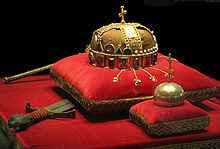 The Holy Crown, a key symbol of Hungary
The Holy Crown, a key symbol of Hungary
In Pest, arguably the most important sight is Andrássy út. As far as Kodály Körönd and Oktogon both sides are lined with large shops and flats built close together. Between there and Heroes’ Square the houses are detached and altogether grander. Under the whole runs continental Europe’s oldest Underground railway, most of whose stations retain their original appearance. Heroes’ Square is dominated by the Millenary Monument, with the Tomb of the Unknown Soldier in front. To the sides are the Museum of Fine Arts and the Kunsthalle Budapest, and behind City Park opens out, with Vajdahunyad Castle. One of the jewels of Andrássy út is the Hungarian State Opera House. Statue Park, a theme park with striking statues of the Communist era, is located just outside the main city and is accessible by public transport.
The city is home to the largest synagogue in Europe (Dohány Street Synagogue),[63] and second largest working in the World .[64] The synagogue is located in the Jewish district taking up several blocks in central Budapest bordered by Király utca, Wesselényi utca, Grand Boulevard (Budapest) and Bajcsy Zsilinszky road. The city is also proud at the largest medicinal bath in Europe (Széchenyi Medicinal Bath) and the third largest Parliament building in the world, once the largest in the world. The third largest church in Europe (Esztergom Basilica) and the second largest Baroque castle in the world (Gödöllő) are in the vicinity.
The world's largest panorama photograph was created in (and of) Budapest in 2010.[65]
-
Heroes' Square with the Millenary Monument
-
Andrássy Avenue, it was recognised as a World Heritage Site
-
City of Budapest seen from Saint Stephen's Basilica
Islands
Seven islands can be found on the Danube: Shipyard Island, Margaret Island, Csepel Island, Palotai-sziget (now a peninsula), Népsziget, Háros-sziget, and Molnár-sziget.
Notable islands include:
- Margaret Island is a 2.5 km (1.6 mi) long island and 0.965 square kilometres (238 acres) in area. The island mostly consists of a park and is a popular recreational area for tourists and locals alike. The island lies between bridges Margaret Bridge (south) and Árpád Bridge (north). Dance clubs, Swimming pools, an Aqua park, athletic and fitness centres, bicycle and running tracks can be found around the Island. During the day the island is occupied by people doing sports, or just resting. In the summer (generally on the weekends) mostly young people go to the island at night to party in its terraces, or to recreate with a bottle of alcohol on a bench or on the grass (this form of entertainment is sometimes referred to as bench-partying).
- Csepel Island (Hungarian pronunciation: [ˈtʃɛpɛlsiɡɛt]) is the largest island of the River Danube in Hungary. It is 48 km (30 mi) long; its width is 6–8 km (3.75–5 mi) and its area comprises 257 km2 (99 sq mi), whereas only the northern tip is inside the city limits.
- Hajógyári-sziget ([ˈhɒjoːɟaːri siɡɛt], or Óbudai-sziget) is a man built island, located in the third district. This island hosts many activities such as: wake-boarding, jet-skiing during the day, and dance clubs during the night. This is the island where the famous Sziget Festival takes place, hosting hundreds of performances per year and now around 400,000 visitors in its last edition. Many building projects are taking place to make this island into one of the biggest entertainment centres of Europe, the plan is to build Apartment buildings, hotels, casinos and a marina.
- Luppa-sziget is the smallest island of Budapest, located in the north region.
Spas
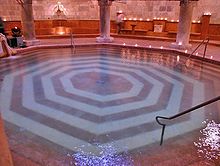 Rudas Baths is a thermal and medicinal bath that was first built in 1550
Rudas Baths is a thermal and medicinal bath that was first built in 1550
One of the reasons the Romans first colonized the area immediately to the west of the River Danube and established their regional capital at Aquincum (now part of Óbuda, in northern Budapest) is so that they could utilize and enjoy the thermal springs. There are still ruins visible today of the enormous baths that were built during that period. The new baths that were constructed during the Turkish period (1541–1686) served both bathing and medicinal purposes, and some of these are still in use to this day. Budapest gained its reputation as a city of spas in the 1920s, following the first realization of the economic potential of the thermal waters in drawing in visitors. Indeed, in 1934 Budapest was officially ranked as a "City of Spas". Today, the baths are mostly frequented by the older generation, as, with the exception of the “Magic Bath” and "Cinetrip" water discos, young people tend to prefer the lidos which are open in the summer. Construction of the Király Baths started in 1565, and most of the present-day building dates from the Turkish period, including most notably the fine cupola-topped pool.
The Rudas Baths are centrally placed – in the narrow strip of land between Gellért Hill and the River Danube – and also an outstanding example of architecture dating from the Turkish period. The central feature is an octagonal pool over which light shines from a 10 m diameter cupola, supported by eight pillars.
The Gellért Baths and Hotel were built in 1918, although there had once been Turkish baths on the site, and in the Middle Ages a hospital. In 1927 the Baths were extended to include the wave pool, and the effervescent bath was added in 1934. The well-preserved Art Nouveau interior includes colourful mosaics, marble columns, stained glass windows and statues.
The Lukács Baths are also in Buda and are also Turkish in origin, although they were only revived at the end of the 19th century. This was also when the spa and treatment centre were founded. There is still something of an atmosphere of fin-de-siècle about the place, and all around the inner courtyard there are marble tablets recalling the thanks of patrons who were cured there. Since the 1950s it has been regarded as a centre for intellectuals and artists.
The Széchenyi Baths are one of the largest bathing complexes in all Europe, and the only “old” medicinal baths to be found in the Pest side of the city. The indoor medicinal baths date from 1913 and the outdoor pools from 1927. There is an atmosphere of grandeur about the whole place with the bright, largest pools resembling aspects associated with Roman baths, the smaller bath tubs reminding one of the bathing culture of the Greeks, and the saunas and diving pools borrowed from traditions emanating in northern Europe. The three outdoor pools (one of which is a fun pool) are open all year, including winter. Indoors there are over ten separate pools, and a whole host of medical treatments is also available.
Transport
Airport
 Map of the Budapest Metro.
Map of the Budapest Metro.
Budapest Liszt Ferenc International Airport, formerly called Budapest Ferihegy International Airport, which has 3 passenger terminals: Ferihegy 1, which tends to serve the many discount airlines now flying to and from Budapest, Ferihegy 2/A and Ferihegy 2/B. Terminal 3 is planned to be built. The airport is located to the east of the centre in the XVIII. district in Pestszentlőrinc. In March 2011, the Hungarian Government announced that the name of the Airport is to be changed from "Budapest Ferihegy International Airport" to "Budapest Liszt Ferenc International Airport".
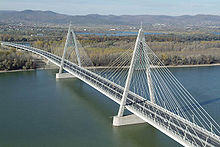 Megyeri Bridge, M0 motorway, north sector.
Megyeri Bridge, M0 motorway, north sector.
Roads
Budapest is the most important Hungarian road terminus; most of the major highways end near the city-limits. The road system in the city is designed in a similar manner to that of Paris, with several ring roads, and avenues radiating out from the center.
Ring road (beltway) M0 around Budapest is nearly completed, with only one section missing on the west side due to local disputes. Currently the beltway is around 80 kilometers in length, and once finished it will be near 100 kilometers of highway in length.
Public transport
Budapest public transport is provided by BKV,[66] the company operates buses, trolleybuses, trams, suburban railway lines, the metro, a boat service, a cogwheel railway, a funicular, and a chairlift, called Libegő.
Budapest's tram network is extensive, and reliable despite poor track infrastructure and an ageing fleet. Routes 4 and 6 combined form the busiest traditional city tram line in the world, with the world's longest passenger trams (54-metre (177 ft) long Siemens Combino) running at 60 to 90 second intervals at peak time and 3–4 minutes off-peak and usually packed with people.
Day services operate from 4:30 a.m. until 11:30 p.m. each day. Night traffic (a reduced overnight service) has a reputation for being excellent.
There are three metro lines and a fourth is currently under construction. The Yellow line, built in 1896, is one of the oldest subway lines in the world, following the London Underground built in 1863.
Railways
Hungarian main-line railways are operated by MÁV. There are three main railway termini in Budapest, Keleti (eastbound), Nyugati (westbound), and Déli (southbound), operating both domestic and international rail services. Budapest was one of the main stops of the Orient Express until 2001, when the service was cut back to Paris-Vienna. There is also a suburban rail service in and around Budapest, operated under the name HÉV.
-
Budapest Western railway station (Hungarian: Budapest Nyugati pályaudvar)
-
Budapest East railway station (Hungarian: Budapest Keleti pályaudvar)
Waterways
The river Danube flows through Budapest on its way to the Black Sea. The river is easily navigable and so Budapest has historically been a major commercial port (at Csepel). In the summer months a scheduled hydrofoil service operates up the Danube to Vienna.
Special vehicles
Beside metros, suburban rails, buses, trams and boats, there are a couple of less usual vehicles in Budapest:
- trolleybus on several lines in Pest
- the Castle Hill Funicular between the Chain Bridge and Buda Castle
- cyclecar for rent in Margaret Island
- chairlift
- the Budapest Cog-wheel Railway
- children's railway [66]
The latter three vehicles run among Buda hills.
Education
Main Building of the BME. One of the oldest universities of technology in the World, founded in 1782.
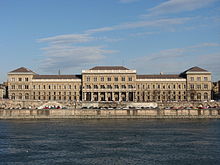 Main Building of the Corvinus University of Budapest
Main Building of the Corvinus University of Budapest
Budapest is Hungary's main centre of education and home to numerous universities:
- Eötvös Loránd University
- Budapest Business School
- Central European University
- Budapest University of Technology and Economics
- Corvinus University of Budapest
- Semmelweis University (medical university)
- Szent István University
- Óbuda University
- Pázmány Péter Catholic University
- Károli Gáspár University of the Hungarian Reformed Church
- Jewish Theological Seminary – University of Jewish Studies
- International Business School-Budapest
- Andrássy Gyula German Language University of Budapest
- Moholy-Nagy University of Art and Design
- Liszt Ferenc Academy of Music
International relations
See also: List of twin towns and sister cities in HungaryTwin towns — Sister cities
Budapest is twinned with:[67][68][69]
Country City County / District / Region / State Date  Turkey
TurkeyIstanbul Istanbul 1985  Austria
AustriaVienna Vienna 1990  Bosnia and Herzegovina
Bosnia and HerzegovinaSarajevo Sarajevo Canton 1995  Turkey
TurkeyIzmir Izmir 1985  Bulgaria
BulgariaSofia Sofia City  China (PRC)
China (PRC)Beijing Beijing 2005[70]  Croatia
CroatiaZagreb Zagreb 1994[71]  France
FranceParis Paris 1956  Germany
GermanyBerlin Berlin 1992[72]  Germany
GermanyFrankfurt am Main Hessen 1990  Indonesia
IndonesiaJakarta Jakarta Special Capital Region 2009[73]  Israel
IsraelTel Aviv Tel Aviv District 1989[74]  Italy
ItalyFlorence Tuscany 2008[75]  Poland
PolandWarsaw Masovian Voivodeship 2005[76]  Portugal
PortugalLisbon District of Lisbon 1992  Romania
RomaniaBucharest Bucharest 1991  Slovakia
SlovakiaKošice Košice Region 1997[77]  South Korea
South KoreaDaejeon Daejeon 1994[78]  Thailand
ThailandBangkok Bangkok 2007  Ukraine
UkraineLviv Ukraine 1993[79]  United States
United StatesFort Worth Texas 1990[80]  Turkey
TurkeyGaziantep Gaziantep 2010  United States
United StatesNew York City New York 1992[81] Some of the city's districts are also twinned to small cities or districts of other big cities, for details see the article List of districts and towns in Budapest.
Partnerships
See also
- Outline of Hungary
- List of cemeteries in Budapest
- List of famous people of Budapest
- Music of Budapest
- Urban and Suburban Transit Association (most of its activity is centred around Budapest)
- Budapest metropolitan area
- Fort Budapest
- List of films shot in Budapest
References
Sources
- DK Publishing, Budapest: Eyewitness Travel Guildes (2007). DK Travel. ISBN 978-0756624354.
- Barber, Annabel (2004). Visible Cities Budapest: A City Guide. Somerset. ISBN 978-9632129860.
- Ungvary, Krisztian (2006). The Siege of Budapest: One Hundred Days in World War II. Yale University Press. ISBN 978-0300119855.
- Molnar, Miklos (2001). A Concise History of Hungary. Cambridge Concise Histories (Fifth printing 2008 ed.). Cambridge, United Kingdom: Cambridge University Press. ISBN 9780521667364.
Notes
- ^ a b Bachmann, Helena (2002-03-18). "Beauty and the Feast". Time. http://www.time.com/time/magazine/article/0,9171,901020325-218419,00.html. Retrieved 2008-05-22.
- ^ "Budapest". Encyclopædia Britannica. Encyclopædia Britannica, Inc.. 2008. http://www.britannica.com/eb/article-9106098/Budapest. Retrieved 2008-01-30.
- ^ "Hungary by data 2009". Hungary Central Statistical Office. 2010-07-16. http://portal.ksh.hu/pls/ksh/docs/hun/xftp/idoszaki/mosz/mosz09.pdf. Retrieved 2010-07-17.
- ^ "Interactive population pyramids of Budapest (1980-2010)". Hungary Central Statistical Office. http://www.ksh.hu/interaktiv/korfa/terulet.html. Retrieved 2011-05-10.
- ^ "Dövényi Zoltán-Kovács Zoltán: A szuburbanizáció térbeni-társadalmi jellemzői Budapest környékén (Spatial and societal parameters of the suburbanization in Budapest)". Földrajzi Értesítő (Geographical Report). http://www.mtafki.hu/konyvtar/kiadv/FE1999/FE19991-2_33-57.pdf. Retrieved 2011-08-29.
- ^ History of the Budapest Commuter Association (English))
- ^ Settlements of the Budapest Commuter Area (Hungarian)
- ^ a b c d e f g h i j k l m n Török, András. "Budapest". Encarta. http://encarta.msn.com/encyclopedia_761572648/Budapest.html. Retrieved 2008-04-06.
- ^ Molnar, A Concise History of Hungary, Chronology pp. 15.
- ^ a b c d e "Aquincum". Encyclopædia Britannica. Encyclopædia Britannica, Inc.. 2008. http://www.britannica.com/EBchecked/topic/31272/Aquincum. Retrieved 2008-05-22.
- ^ Sugar, Peter F.; Péter Hanák, Tibor Frank (1990). "Hungary before the Hungarian Conquest". A History of Hungary. Indiana University Press. p. 3. ISBN 025320867X. http://books.google.com/?id=SKwmGQCT0MAC&printsec=frontcover. Retrieved 2008-05-19.
- ^ a b c d e f "Budapest". Travel Channel. http://guides.travelchannel.com/budapest/city-guides/historical-background. Retrieved 2008-05-22.
- ^ a b c "Budapest". 1911 Encyclopædia Britannica Eleventh Edition. http://en.wikisource.org/wiki/1911_Encyclop%C3%A6dia_Britannica/Budapest. Retrieved 2008-01-30.
- ^ Drake, Miriam A. (2003). "Eastern Europe, England and Spain". Encyclopedia of Library and Information Science. CRC Press. pp. 2498. ISBN 0824720806. http://books.google.com/?id=w1Xtjiyh9XYC&pg=PA2494#PPA2498,M1. Retrieved 2008-05-22.
- ^ Casmir, Fred L. (1995). "Hungarian culture in communication". Communication in Eastern Europe: The Role of History, Culture, and media in contemporary conflicts. Lawrence Erlbaum Associates. p. 122. ISBN 0805816259. http://books.google.com/?id=be2UW6NyposC&pg=PA115. Retrieved 2008-05-21.
- ^ Molnar, A Concise History of Hungary, Chronology pp. 15
- ^ Beaverstock, J. V.; R. J. Smith, P. J. Taylor (1999). A Roster of World Cities. Loughborough University. http://www.lboro.ac.uk/gawc/rb/rb5.html. Retrieved 2008-05-22.
- ^ a b "Nomination of the banks of the Danube and the district of the Buda Castle". International Council on Monuments and Sites. http://whc.unesco.org/archive/advisory_body_evaluation/400bis.pdf. Retrieved 2008-01-31.
- ^ Lyman, Rick (2006-10-03). "Budapest Is Stealing Some of Prague’s Spotlight". The New York Times. http://travel.nytimes.com/2006/09/03/travel/03journey.html. Retrieved 2008-01-29.
- ^ "World Heritage Committee Inscribes 9 New Sites on the World Heritage List". Unesco World Heritage Centre. http://whc.unesco.org/en/news/156. Retrieved 2008-01-31.
- ^ "Hungary's, Budapest's and Balaton's Guide: Budapest's spas: Gellért, Király, Rác, Ru..'l'; l;lldas, Széchenyi, Lukács"]. Guideviaggi.net. http://www.guideviaggi.net/en_budapest_spas.asp. Retrieved 2009-07-07.
- ^ Published: 10:25AM Wednesday November 19, 2008 (2008-11-19). "Big underground thermal lake unveiled in Budapest, Hungary | WORLD News". Tvnz.co.nz. http://tvnz.co.nz/view/page/425822/2319289. Retrieved 2009-07-07.
- ^ "Euromonitor International’s top city destinations ranking". Euromonitor. http://www.euromonitor.com/euromonitor-internationals-top-city-destinations-ranking/article. Retrieved 2011-02-23.
- ^ "Doing Business : Budapest, the soul of Central Europe". International Herald Tribune. 2004-08-04. http://www.iht.com/articles/2004/08/04/trbuda_ed3_.php. Retrieved 2008-01-29.[dead link]
- ^ "New MasterCard Research Ranks 65 Cities in Emerging Markets Poised to Drive Long-Term Global Economic Growth | MasterCard". Mastercard.com. 2008-10-22. http://www.mastercard.com/us/company/en/newsroom/pr_new_mastercard_research_ranks_65_Cities_in_emerging_markets.html. Retrieved 2009-07-07.
- ^ "Index - Külföld - Budapest a legélhetőbb európai nagyváros". Index.hu. 2008-07-07. http://index.hu/kulfold/2009/06/08/budapest_a_legelhetobb_europai_nagyvaros/. Retrieved 2009-07-07.
- ^ "Gazdaság: EIU: Budapest, London és New York között a legjobban élhető városok listáján". HVG.hu. 1970-01-01. http://hvg.hu/gazdasag/20100211_eiu_legelhetobb_varosok_listaja_2010_vanc. Retrieved 2011-09-15.
- ^ Beckett, Edward; Olson, Parmy. "In Pictures: Europe's Most Idyllic Places To Live". Forbes. http://www.forbes.com/2008/11/18/europe-homes-dollar-forbeslife-cx_po_1118realestate_slide_5.html.
- ^ http://www.ucityguides.com/cities/top-10-most-beautiful-cities.html
- ^ "Innovation Cities™ Top 100 Index » Innovation Cities Index & Program – City data training events from 2THINKNOW for USA Canada America Europe Asia Mid-East Australia". Innovation-cities.com. 2010-09-01. http://www.innovation-cities.com/innovation-cities-top-100-index-top-cities/. Retrieved 2011-09-15.
- ^ "CEE City Ranking puts capitals under the spotlight | Local and regional publications | Publications | Home | Strategy Consultants". Rolandberger.at. http://www.rolandberger.at/publications/local_and_regional_publications/2009-05-28-CEE_city_ranking_2009_en.html. Retrieved 2011-09-15.
- ^ "EU nations pick Budapest for technology institute". International Herald Tribune (The New York Times Company). 2008-06-18. http://www.iht.com/articles/ap/2008/06/18/europe/EU-GEN-EU-Technology-Institute.php. Retrieved 2008-06-20.
- ^ MTI. "hírek szünet nélkül : Kínai nagyfalat - Budapesten nyílik az első kínai befektetési támaszpont külföldön". hvg.hu. http://hvg.hu/gazdasag.hazai/20090526_kinai_befektetesi_kozpont_budapesten.aspx. Retrieved 2009-07-07.
- ^ Sugar, Peter F. (1990). "Hungary before the Hungarian Conquest". A History of Hungary. Indiana University Press. p. 5. ISBN 9780253208675. http://books.google.com/?id=SKwmGQCT0MAC&pg=PR9&dq=The+Romans+roads,+amphitheaters+Aquincum+%C3%93buda. Retrieved 2008-06-03.
- ^ B. Dimitrov, Bulgarians- Civilizers of the slavs, p.48
- ^ Molnar, A Concise History of Hungary, Chronology pp. 12
- ^ Molnar, A Concise History of Hungary, p. 14
- ^ a b Sugar, Peter F. (1990). "The Angevine State". A History of Hungary. Indiana University Press. p. 48. ISBN 9780253208675. http://books.google.com/?id=SKwmGQCT0MAC&pg=PR9&dq=Hungarian+university+1395+Buda. Retrieved 2008-06-03.
- ^ Mona, Ilona (1974). "Hungarian Music Publication 1774–1867". Studia Musicologica Academiae Scientiarum Hungaricae (Akadémiai Kiadó) 16 (1/4): 261–275. doi:10.2307/901850. JSTOR 901850.
- ^ a b Southeastern Europe under Ottoman rule, 1354-1804, Peter F. Sugar, page 88
- ^ now to post a comment! (2007-10-24). "Horthy bevonul Budapestre". YouTube. http://www.youtube.com/watch?v=9smq580awFg&feature=related. Retrieved 2011-09-15.
- ^ Nationalism and the Problem of Inclusion in Hungary. Alice Freifeld , Associate Professor of History at the University of Florida, and a former Title VIII-supported EES Short-term Scholar.
- ^ Encyclopedia Britannica 1911, Budapest article
- ^ Macartney, C.A. (1937). Hungary and her successors - The Treaty of Trianon and Its Consequences 1919–1937. Oxford University Press.
- ^ Bernstein, Richard (2003-08-09). "East on the Danube: Hungary's Tragic Century". The New York Times. http://query.nytimes.com/gst/fullpage.html?res=9B07E3D91531F93AA3575BC0A9659C8B63&sec=&spon=&pagewanted=2. Retrieved 2008-03-15.
- ^ "Budapest". United States Holocaust Memorial Museum. http://www.ushmm.org/wlc/article.php?lang=en&ModuleId=10005264. Retrieved 2007-07-18.
- ^ "Raoul Wallenberg". Jewish Virtual Library.
- ^ Statue of Harry Hill Bandholtz
- ^ "Road Reconstruction Portal". Official Webpage of the Local Government of Budapest. http://www.budapestportal.eu/utfelujitas.
- ^ "Article on Infrastructural Investments". Official Webpage of the Local Government of Budapest. http://www.budapest.hu/engine.aspx?page=20080610-cikk-kozlekedesi_beruhazasok.
- ^ "News on the reconstruction of Margaret Bridge". Official Webpage of the Local Government of Budapest. 2008-06-10. http://www.budapest.hu/engine.aspx?page=2009-villamosfelujitas.
- ^ Central Wastewater Treatment Plant
- ^ "Budapest:When to go". Lonely Planet. http://www.lonelyplanet.com/worldguide/hungary/budapest/when-to-go. Retrieved 2008-04-06.
- ^ "Monthly Averages for Budapest, Hungary (based on data from 1901–2010)". Hungarian Meteorological Service. http://www.met.hu/pages/climate/bp/index.htm. Retrieved 2010-06-04.
- ^ a b "FIFA introduces new FIFA Puskás Award to honour the "goal of the year"". FIFA.com. http://www.fifa.com/classicfootball/releases/newsid=1120531.html. Retrieved 2011-09-15.
- ^ [1][dead link]
- ^ http://www.bandyvm.se/RTE/my_documents/my_pictures/VM_2004/budapest.jpg
- ^ Budapest statisztikai évkönyve 1944-1946 (Statistical Yearbook of Budapest, 1944-1946), p. 12, Hungarian Central Statistical Office
- ^ "Population by nationalities". Hungarian Central Statistical Office. 2001. http://www.nepszamlalas.hu/eng/volumes/06/01/tabeng/4/load01_11_0.html. Retrieved 2008-05-30.
- ^ a b c d e "Budapest's population is increasing (Növekszik Budapest népessége)". Index.hu. 2010. http://index.hu/belfold/budapest/2010/02/24/novekszik_budapest_nepessege/. Retrieved 2010-03-30.
- ^ "Population by religions, denominations". Hungarian Central Statistical Office. 2001. http://www.nepszamlalas.hu/eng/volumes/18/tables/load3_12.html. Retrieved 2008-05-30.
- ^ "Downtown and Districts", Budapest Corner, http://budapestcorner.com/index.php/news/information/budapest-districts, retrieved 2010-12-14
- ^ Kulish, Nicholas (2007-12-30). "Out of Darkness, New Life". The New York Times. http://travel.nytimes.com/2007/12/30/travel/30dayout.html?scp=1&sq=largest+synagogue+in+Europe&st=nyt. Retrieved 2008-03-12.
- ^ "In the Neighbourhood: the Synagogue". Hotel Ambra. http://www.hotelambra.hu/index.php?page=neigh2&lang=eng.
- ^ "The largest photo on Earth - created by 360world.eu". 70 Billion Pixels Budapest. http://www.70-billion-pixels-budapest.com/index_en.html. Retrieved 2011-09-15.
- ^ a b Rail, Evan (2007-08-12). "36 Hours in Budapest". The New York Times. http://travel.nytimes.com/2007/08/12/travel/12hours.html?scp=10&sq=Budapest&st=nyt. Retrieved 2008-01-29.
- ^ "Sister City - Budapest". Official website of New York City. http://www.nyc.gov/html/unccp/scp/html/sc/budapest_main.shtml. Retrieved 2008-05-14.
- ^ "Sister cities of Budapest" (in Hungarian). Official Website of Budapest. http://www.budapest.hu/engine.aspx?page=20030224-cikk-testvervarosok. Retrieved 2008-01-31.
- ^ "Who knows less about Budapest? A quiz with mayor candidates" (in Hungarian). Index. http://index.hu/politika/belfold/budapest/kvizkerdes74/. Retrieved 2008-01-31.
- ^ "Sister Cities". Beijing Municipal Government. http://www.ebeijing.gov.cn/Sister_Cities/Sister_City/. Retrieved 2009-06-23.
- ^ "Intercity and International Cooperation of the City of Zagreb". © 2006–2009 City of Zagreb. http://www1.zagreb.hr/mms/en/index.html. Retrieved 2009-06-23.
- ^ "Berlin's international city relations". Berlin Mayor's Office. Archived from the original on August 22, 2008. http://web.archive.org/web/20080822100321/http://www.berlin.de/rbmskzl/staedteverbindungen/index.en.html. Retrieved 2009-07-01.
- ^ "The Jakarta Post - Hungarian envoy builds new links with RI". The Jakarta Post. http://www.thejakartapost.com/news/2009/07/13/hungarian-envoy-builds-new-links-with-ri.html.
- ^ "Tel Aviv sister cities" (in Hebrew). Tel Aviv-Yafo Municipality. http://www.tel-aviv.gov.il/Hebrew/Cityhall/TwinCities/Index.asp. Retrieved 2009-07-01.
- ^ "Hízelgő a magyar fővárosnak: Firenze testvérvárosának fogadta" (in Hungarian). Népszabadság. Ringier. 2008-05-17. http://nol.hu/budapest/cikk/492160/. Retrieved 2008-05-30.
- ^ "Miasta partnerskie Warszawy". um.warszawa.pl. Biuro Promocji Miasta. 2005-05-04. http://um.warszawa.pl/v_syrenka/new/index.php?dzial=aktualnosci&ak_id=3284&kat=11. Retrieved 2008-08-29.
- ^ "Partnership towns of the City of Košice" (in Slovak). © 2007-2009 City of Košice Magistrát mesta Košice, Tr. SNP 48/A, 040 11 Košice. http://www.kosice.sk/clanok.asp?file=gov_s_c-00.html. Retrieved 2009-07-12.
- ^ Daejeon.kr[dead link] Daejeon.kr[dead link]
- ^ http://www.city-adm.lviv.ua/index/cities-partners
- ^ "Fort Worth Sister Cities". fwsistercities.org. http://www.fwsistercities.org/. Retrieved 17 February 2010.
- ^ "NYC's Sister Cities". Sister City Program of the City of New York. 2006. http://www.nyc.gov/html/unccp/scp/html/sc/main.shtml. Retrieved 2008-09-01.
- ^ "Kraków otwarty na świat". www.krakow.pl. http://www.krakow.pl/otwarty_na_swiat/?LANG=UK&MENU=l&TYPE=ART&ART_ID=16. Retrieved 2009-07-19.
External links
- Official homepage
- Budapest Tourism Office
- Public transport in Budapest
- MÁV-Start Railway Passenger Transport Co.
- Budapest Info
- Budapest on Facebook
- Budapest travel guide from Wikitravel
- Beautiful Budapest: Vintage Photos - slideshow by Life magazine
- 70 gigapixel photo of Budapest
- Budapest All in One Guide
- Personalised Budapest
- Budapest Guide
Counties of Hungary Counties Bács-Kiskun · Baranya · Békés · Borsod-Abaúj-Zemplén · Csongrád · Fejér · Győr-Moson-Sopron · Hajdú-Bihar · Heves · Jász-Nagykun-Szolnok · Komárom-Esztergom · Nógrád · Pest · Somogy · Szabolcs-Szatmár-Bereg · Tolna · Vas · Veszprém · Zala
Urban counties Békéscsaba · Budapest (capital) · Debrecen · Dunaújváros · Eger · Érd · Győr · Hódmezővásárhely · Kaposvár · Kecskemét · Miskolc · Nagykanizsa · Nyíregyháza · Pécs · Salgótarján · Sopron · Szeged · Székesfehérvár · Szekszárd · Szolnok · Szombathely · Tatabánya · Veszprém · ZalaegerszegNUTS regions of Hungary NUTS 1 NUTS 2 NUTS 3 Bács-Kiskun · Baranya · Békés · Borsod-Abaúj-Zemplén · Budapest · Csongrád · Fejér · Győr-Moson-Sopron · Hajdú-Bihar · Heves · Jász-Nagykun-Szolnok · Komárom-Esztergom · Nógrád · Pest · Somogy · Szabolcs-Szatmár-Bereg · Tolna · Vas · Veszprém · ZalaCapital cities of the Member States of the European Union 
World Heritage Sites in Hungary Central Budapest, including the Banks of the Danube, the Buda Castle Quarter and Andrássy Avenue
Transdanubia Early Christian Necropolis of Pécs (Sopianae) · Fertő / Neusiedlersee Cultural Landscape1 · Millenary Benedictine Abbey of Pannonhalma and its Natural Environment
Great Plain
and NorthCaves of Aggtelek Karst and Slovak Karst2 · Hortobágy National Park – the Puszta · Old Village of Hollókő and its Surroundings · Tokaj Wine Region Historic Cultural Landscape
1 Shared with Austria · 2 Shared with Slovakia The Danube Countries 
Cities Tributaries Islands List of crossings Categories:- Budapest
- Capitals in Europe
- Populated places on the Danube
- Spa towns in Hungary
- World Heritage Sites in Hungary
- Roman legions' camps in Central Europe
- NUTS 3 statistical regions of the European Union
- Populated places established in 1873
- County seats in Hungary
Wikimedia Foundation. 2010.

